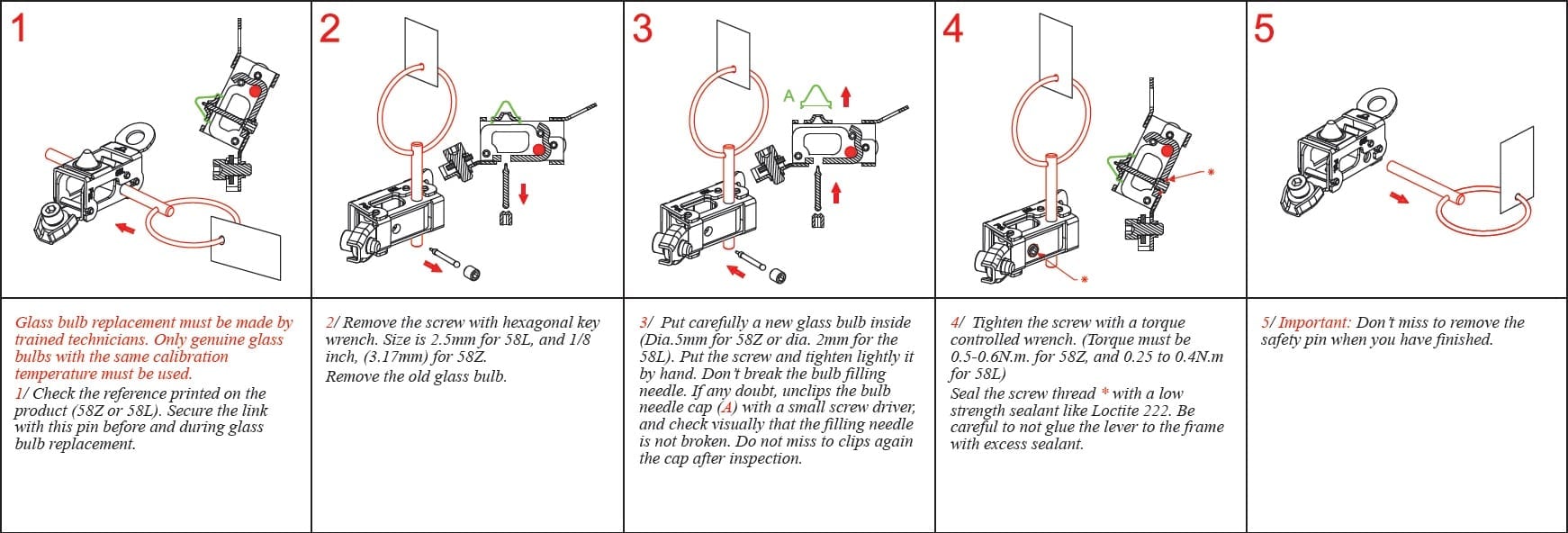Breakable glass bulb fire detection link, miniature type
Patented mechanical system of fire detection by liquid filled glass bulb breaking. In case of fire, when the temperature reaches the liquid boiling temperature, it causes the explosion of the glass bulb, which releases the mechanism
| Maximum permanent load (DaN) | |
|---|---|
| Tensile strength at break (DaN) | |
| Minimum load (DaN) | |
| RTI (m.s^1/2) | |
| Release temperature (°C) |
Applications
Patented mechanical system of fire detection by liquid filled glass bulb breaking. In case of fire, when the temperature reaches the liquid boiling temperature, it causes the explosion of the glass bulb, which releases the mechanism. This self-powered mechanism does not require power supply such as electricity or compressed air. It can open smoke vents, skylights, in buildings, but also actuate fire doors, air conditioning dampers, store curtains, flammable gas or liquid valves, range hood exhausts, paint and solvent exhaust fans and dampers, etc.
Dimensions: Very small foot print, can replace most of devices using fusible links. In addition, having a very high tensile strength, this device does not require a demultiplying system.
Creep sensitivity: Insensitive to creep, even close to the tripping temperature.
ROHS compliance: For most of temperature calibration, fusible fire detection systems cannot be achieved, as they use alloys containing lead and cadmium, materials that are not allowed by the RoHS standard. This glass bulb operated device does not use fusible alloy and therefore contains no prohibited metal and meets the RoHS standard.
Material: Galvanized steel
Fail safe operation: When opening, the internal lever falls unhindered by any other part, irreversibly releasing the two halves of the mechanism.
This mechanism has no spring because, due to their susceptibility to corrosion and to permanent deformation, the use of springs may cause a malfunction.
Glass bulbs: dia. 2mm, 16mm nominal length, filled with alcohols blends.
Response time index (RTI) of bare bulbs: <25 m.s1/2
Maximum permanent load: 100 DaN
Tensile strength at break: ≥ 150 DaN
Minimum load: 5 DaN
Nominal opening temperatures: 57 °C (135 °F) orange bulb; 68 °C (155° F) red. The bulb coloring complies with EN 12259-1 and ISO 6182-1 international standards for color/temperature ratings. Other temperatures, consult us.
Mounting: This model features
- One side with a hole allowing the connection either on a cable, or on a bracket integral with the opening (available as accessories)
- One side with integrated clamping device on steel cable, simplifying
Mounting position: When used in vertical position, the glass bulb must be downside. No preferential position when mounted horizontally.
Options: Rope thimble assembled on the 8mm hole
Glass bulb replacement: Replacement is possible, by using a locking pin, which must be removed after bulb replacement.
Certifications: according to ISO 10294-4.
Main references
|
Temperature (°C/°F) |
Dia. 8mm holes without rope thimble |
Dia. 8mm holes with rope thimble |
| 57°C (135°F) | 58LFF08250B057C0 | 58LFF08250B057C2 |
| 68°C (155°F) | 58LFF08250B068C0 | 58LFF08250B068C2 |
Accessories and spare parts
 |
 |
 |
 |
 |
||||
 |
 |
 |
 |
 |
||||
| Rope thimble (DIN6899A) for steel wire ropes dia. 3 to 3.5mm, 300 DaN max. load.
(Packing unit 20p.) |
Rope clamp for steel wire ropes dia. 3 to 3.5mm, 300 DaN max. load.
(Packing unit 1Op.) |
Wall mounting board, 300 DaN max. load.
(Packing unit lp.) |
Safety pin for glass bulb replacement.
(Packing unit 5p.) |
Dia. 2 x 16mm glass bulb
(Packing unit 50 and 500p) |
||||
| Zinc plated steel | 6658RT034Z | Zinc plated steel | 6658RC036Z | Zinc plated steel | 6658RW035Z | 6658PG001Z | 57°C (135°F) | 6658LGBB057 |
| 68°C (155°F) | 6658LGBB068 | |||||||
Replacement of glass bulb (When requested by preventive maintenance rules)

Downloads
Datasheet
Related products
Humidistat with ingress protection housings
Electromechanical humidistats
Mechanical humidistats for incorporation side shaft adjustment
Rod temperature limiter boxes
Electromechanical humidistats
Miniature mechanical humidistat module, for incorporation. 30-100% relative humidity range
Technical informations associated to this product
-
Description of temperature controls
Used as control thermostats or as a safety thermostat with manual reset, these thermostats have a disc made of two different metals laminated together for temperature sensing element. These two metals have different expansion coefficients. -
Historical introduction to temperature measurement
The temperature measurement was preceded by a long period, throughout the 18th century, when first empirically and then gradually more accurately, have been developed measurement scales, were discovered fixed points for the calibration of these scales, and all physical variations related to temperature change: thermal expansion of gases, liquids, metals and other solids, liquefaction temperatures, boiling temperature, magnetism, thermoelectricity, just to give a few. -
Historical and technical introduction of fusible alloys and fire safety fusible links
The earliest known piece made of lead and tin alloy seems to be an Egyptian vase found in Abydos, dated around 1400 BC. During the Roman Empire, lead was used for the construction of water pipes. Melting at 325°C, -
Temperature sensing principles
The bimetal strip is formed by two co-laminated metal. One has a high coefficient of expansion, the othera lower or zero. When the strip is heated, it bends proportionally to the temperature. These bimetal blades are generally flat and fixed at one end. But they can be wound in a spiral shape, although this arrangement most often used in the construction of thermometers.





















